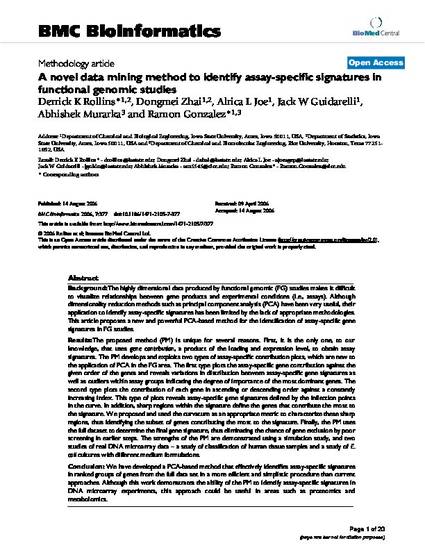
Background: The highly dimensional data produced by functional genomic (FG) studies makes it difficult to visualize relationships between gene products and experimental conditions (i.e., assays). Although dimensionality reduction methods such as principal component analysis (PCA) have been very useful, their application to identify assay-specific signatures has been limited by the lack of appropriate methodologies. This article proposes a new and powerful PCA-based method for the identification of assay-specific gene signatures in FG studies. Results: The proposed method (PM) is unique for several reasons. First, it is the only one, to our knowledge, that uses gene contribution, a product of the loading and expression level, to obtain assay signatures. The PM develops and exploits two types of assay-specific contribution plots, which are new to the application of PCA in the FG area. The first type plots the assay-specific gene contribution against the given order of the genes and reveals variations in distribution between assay-specific gene signatures as well as outliers within assay groups indicating the degree of importance of the most dominant genes. The second type plots the contribution of each gene in ascending or descending order against a constantly increasing index. This type of plots reveals assay-specific gene signatures defined by the inflection points in the curve. In addition, sharp regions within the signature define the genes that contribute the most to the signature. We proposed and used the curvature as an appropriate metric to characterize these sharp regions, thus identifying the subset of genes contributing the most to the signature. Finally, the PM uses the full dataset to determine the final gene signature, thus eliminating the chance of gene exclusion by poor screening in earlier steps. The strengths of the PM are demonstrated using a simulation study, and two studies of real DNA microarray data - a study of classification of human tissue samples and a study of E coli cultures with different medium formulations. Conclusion: We have developed a PCA-based method that effectively identifies assay-specific signatures in ranked groups of genes from the full data set in a more efficient and simplistic procedure than current approaches. Although this work demonstrates the ability of the PM to identify assay-specific signatures in DNA microarray experiments, this approach could be useful in areas such as proteomics and metabolomics.
Available at: http://works.bepress.com/derrickk_rollins/9/

This article is from BMC Bioinformatics 7 (2006): article no. 377, doi: 10.1186/1471-2105-7-377.